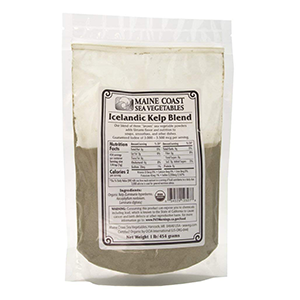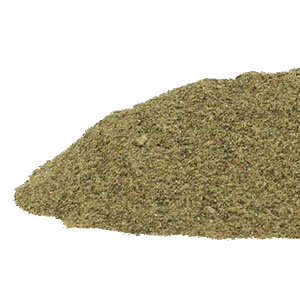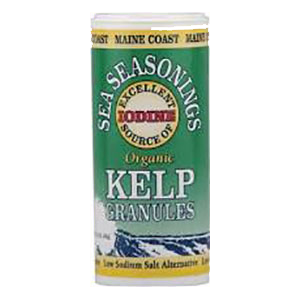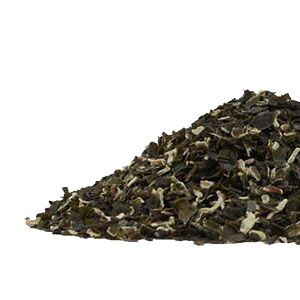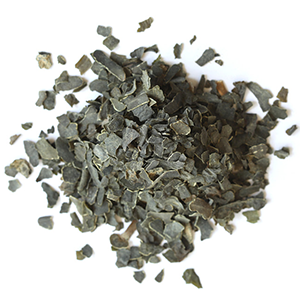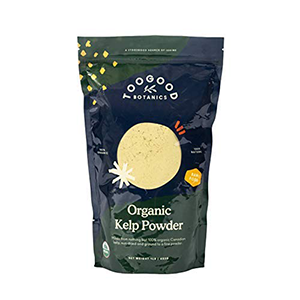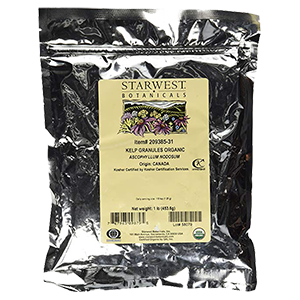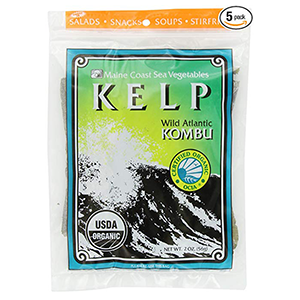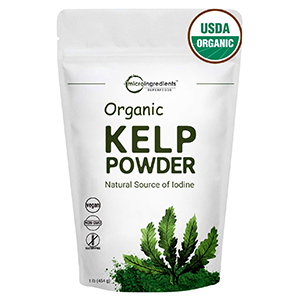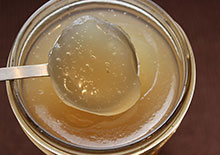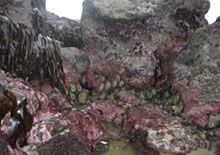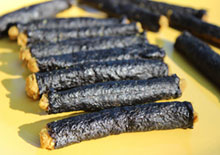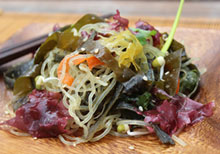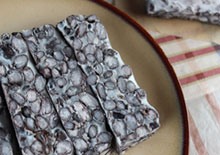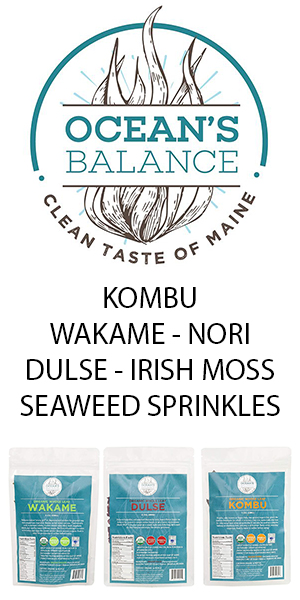Benefits of Kelp Seaweed, A Concentrated Source of Dietary Minerals

Kelp is a general term used to describe a broad range of over 300 species of brown marine algae that grow wild in shallow open ocean waters all over the world. Many varieties of this seaweed are found in underwater giant kelp forests, believed to have first appeared on Earth around 5-23 million years ago.
Providing one of the most productive and dynamic ecosystems on the planet, giant kelp and other related species are the largest and fastest growing of all the sea vegetables.
Kelps are particularly known for their efficient ability to absorb and concentrate a high amount of minerals and other micronutrients from seawater into their multicellular, thick leaf-like blades.
They are thus a highly nutritious edible food source for many aquatic creatures and can be equally harvested, dried and consumed as a dietary supplement for humans alike.
Different kelp seaweed species have been revered throughout human history by inhabitants of coastal locations for their medicinal qualities.
Mineral-rich powders or whole seaweeds nutritionally fortify the diet and are traditionally used in soup stocks for nourishing extremely emaciated or weak individuals
Many of the kelp seaweed types are specifically higher in bioavailable iodine, which is often helpful for correcting iodine deficiency. If you do not have enough iodine in your body, you cannot make the required amount of thyroid hormones. Over time, this can cause symptoms of fatigue, low metabolism and weight gain issues associated with hypothyroidism and goiter.
Today, cultivated kelp and its by-products, like algin or sodium alginate, are used extensively in the food industry as a gelling medium and thickening agent. Kelp extracts are likewise used commercially in cosmetics, agricultural amendments, livestock feed supplements and many other industrial products.
Brown seaweeds are widely consumed as a regular part of the diet in East Asia, especially Japan, China and Korea. One of the most popular ways to use kelp varieties is when preparing traditional Japanese "miso soup", consisting of a stock base called "dashi" of which kombu is one of the main ingredients.
Some common
seaweeds many people are familiar with, like wakame, arame and sea palm, in addition to kombu, all belong to the family of kelps.

What is Kelp Seaweed?
"Kelp" is a general term for seaweeds that come from a class of brown marine algaes, Phaeophyceae, most genera of which come from the order Laminariales and are usually an olive-brown to red-brown color.
These distinct types range in length, nutrient profiles and taste qualities. Although kelp is sometimes also generically referred to by the name "Laminaria", not all kelp comes from this genus.
One of the widely identified "giant kelp" species, for example, comes from the genus Macrocystis, like Macrocystis pyrifera, a fast growing, dense, vertical underwater forest canopy that provides a diverse microenvironment for many different sea plants and creatures.
All kelp species, however, are known to rapidly proliferate when they have an adequate amount of sunlight to do so. Most have gas-filled bladders, called pneumatocysts, which help the plant float from its anchored location, providing buoyancy close to the "surface layer." This is a sunlit zone which extends about 660 feet (200 meters) below sea level.
Some kelp species have very thick wide fronds or large leaf-like blades attached to a main stipe. These fronds are multicellular and easily uptake nutrients in the waters in which they grow.
This is the part of the seaweed harvested for human consumption, commonly available as a dried sea vegetable, concentrated powder or encapsulated supplement.
Some of the most common species of kelp gathered for dietary use include:
- Laminaria digitata
- Saccharina latissima (Laminaria saccharina)
- Ascophyllum nodosum
- Laminaria hyperborea
- Saccharina japonica (Laminaria japonica)
- Undaria pinnatifida (wakame)
- Alaria esculenta (wakame)
Most species grow worldwide in temperate to arctic seawater that is between 43-56 °F (6-14 °C) as more nutrients are found in colder ocean waters. Sufficient nutrient levels are needed to foster their growth. Seaweed collected in colder oceanic zones is known to have a greater concentration of minerals and polysaccharides than more tropical species found in seawater closer to 70 °F (21 °C).
The Kelp Species: Kombu and Wakame
Kelps are often loosely referred to as "kombu", but not all kelp is from the main kombu species, Saccharina japonica (Laminaria japonica). This is a type of sea vegetable indigenous to Japan and Korea, where it is now frequently cultivated on a large scale for commercial use. Some seaweeds, not of this specific species, are often generically called "kombu" because of their thick leathery texture and mucilaginous nature.
Wakame (Undaria pinnatifida) is another Japanese species, also widely consumed in Asian cultures and often sea farmed, like kombu. Another highly nutritious species, closely related to Japanese wakame, is wild Atlantic wakame (Alaria esculenta), which grows prolifically in colder northern climate zones like the coastal waters of Iceland where it is referred to as "marinkjarni."
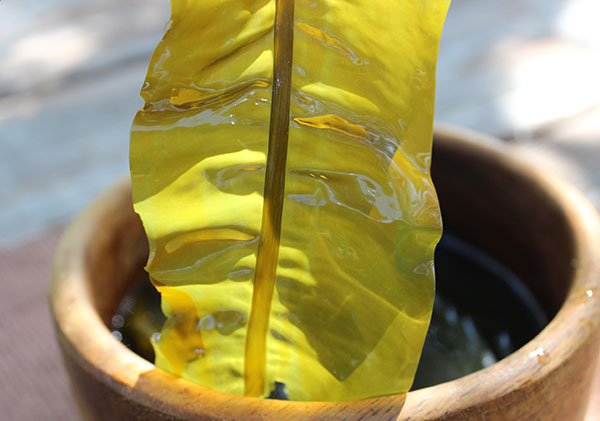
As we mentioned, other sea vegetables are considered a type of kelp including popular varieties like arame and sea palm. However, these species generally have different nutritional components than the larger kelp variety we are discussing here on this page.
When purchasing seaweed, it is especially important to select higher quality brands that are from more pristine seawaters located in the Northern Hemisphere. Some seaweeds are now additionally tested for chemical pollutants and radioactive isotopes that are sometimes present in ocean waters.
Benefits of Kelp Seaweed
A Source of Iodine, Helpful for Thyroid Function
Iodine is a particularly important micronutrient essential for healthy thyroid function and its hormone production. Because iodine is not naturally produced by the body, it needs to be consumed through dietary sources. Seaweeds can be excellent whole food choices for iodine supplementation and can help to protect the thyroid gland and its primary role in regulating metabolism.
All kelps are classes of brown seaweeds that are known to be predominantly efficient at absorbing iodine from oceanic environments. In a study published by the National Academy of Sciences it was emphasized that "Brown algae of the Laminariales (kelps) are the strongest accumulators of iodine among living organisms."
For the average person, consuming kelp in foods or as an encapsulated powder can provide an easy way to meet essential iodine requirements necessary for maintaining proper metabolic functions and is especially appropriate when mineral deficiency is an issue.
While we feel that adding some kind of seaweed to the diet on a frequent basis can be beneficial by delivering a well-balanced ratio of minerals and nutrients, some varieties may be more suitable for some people than for others.
It is important to note that on rare occasions some
individuals may be sensitive to the higher amounts of iodine found in
kelp and may wish to consume other sea vegetables (like nori or dulse) instead, as a way to prevent potential iodine overdose.
Why We May Need More Iodine
Although the amount of iodine humans require daily is largely debated by many health professionals, the dose currently recommended by the U.S. RDA is 150 micrograms (0.15 milligrams) per day in adults who are not pregnant or lactating.
Many health experts argue that these numbers, which were originally intended to prevent goiter, do not take into account the increasing amount of goitrogens present in today's world. When accumulated, goitrogenic substances can interfere with iodine uptake in the thyroid gland.
Iodine deficiencies are known to occur from daily exposure
to common chemicals like bromine, chlorine and fluoride, all of which displace iodine and
prevent its proper absorption. Bromine is found in such things as
computer plastics, pesticides, soft drinks, baked flour products,
medical drugs and fire retardants. Chlorine and fluoride are often found
in tap water.
The thyroid can also uptake radioactive iodine,
like cesium 137, when there is iodine deficiency, increasing the risk of thyroid cancer. In some cases, as with
the nuclear Fukushima disaster in Japan, it may also be necessary to take a high
quality concentrated iodine supplement to protect the thyroid gland from exposure.
Current 2016 U.S. Recommend Daily Allowance for Iodine:
- 150 micrograms (0.15 mg) per day for adult men and women
- 220 mcg for pregnant women (0.22 mg)
- 290 mcg for lactating/breastfeeding women (0.29 mg)
A 2013 published review in the journal Thyroid it was concluded that, "We propose that the International Council for the Control of Iodine Deficiency Disorders considers the importance of these studies and recommend, for pathologies of tissues that take up iodine and under the care of a physician, an iodine intake of at least 3 mg/day [3000 mcg] in the form of I2 [molecular iodine]."
Conversely, according to the American Thyroid Association "Ingestion of greater than 1,100 mcg (1.1 mg) of iodine per day (Tolerable Upper Limits for iodine) is not recommended and may cause thyroid dysfunction." (Source)
Although it is important to note that some research does indicate that "too much iodine" in the diet can indeed increase risk of developing iodine-induced thyroid disorders in certain susceptible individuals, these incidences are not pertinent to all people.
In a published 2014 review entitled "Consequences of Excess Iodine" it was determined that "Although excess iodine exposure generally does not result in any apparent clinical consequences, thyroid dysfunction can occur in vulnerable patients with specific risk factors, including those with pre-existing thyroid disease, the elderly, fetuses and neonates."
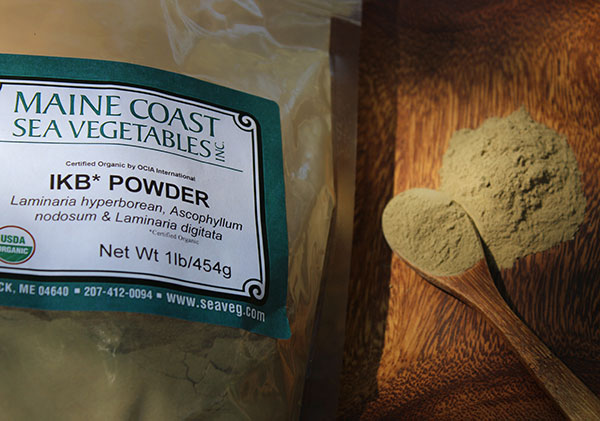
Iodine Deficiency and Hypothyroidism
Often associated with iodine deficiency, hypothyroidism (or an under-active thyroid gland) is a condition that is becoming more prevalent in today's modern world. This is a disorder in which the thyroid is not producing enough thyroid hormones needed for optimal balance.
Iodine deficiency might also contribute to other autoimmune conditions such as chronic fatigue syndrome and fibromyalgia.
Kelp, along with bladderwrack, is one of the most bioavailable sources of iodine among all the seaweed varieties and can be a great way to provide this hard to find essential trace mineral. (*)
When a person is "hyper" thyroid, whereby the thyroid is producing too many hormones, iodine should be avoided in large amounts. However, some iodine in small increments is very helpful for detoxification and rejuvenation of the gland.
When discussing ways to help balance thyroid hormones, in treatment or prevention of both hypothyroidism or hyperthyroidism, there are many complex factors involved with each unique individual, including one's current state of health.
It is important that you do your own research and seek the advice of a qualified endocrinologist or medical physician to help evaluate your own distinct hormonal profile using the appropriate laboratory testing procedures.
The conventional way to test relies primarily on the TSH test to diagnose a thyroid condition, but this method is believed to be highly inaccurate by many leading holistic health authorities. It is often recommended that a complete analysis should not just rely on standard TSH testing, but should also include tests for total T4, free T4, total T3, free T3 and the reverse T3.
High in Other Minerals
Wild kelp that is nourished by nutrient-rich seawater found in pristine colder marine environments in the Northern Hemisphere is known to be one of the most potent sources of minerals available in the plant kingdom.
Compared to other sea vegetables, it is definitely one of the more nutrient-dense varieties and on our top 10 superfoods list for this reason.
Aside from its very high iodine concentration, it is also a source of iron, magnesium, chromium, calcium, sodium and potassium as well as lower amounts of zinc and selenium.
When consumed in its natural unrefined state, kelp offers these minerals in a bioavailable form for greatest absorption and nutritional utilization.
Many people today suffer unknowingly from mineral deficiency because of a past history of poor eating habits and/or because of the low mineral content present in many cultivated foods we consume on a regular basis. Compared to previous generations, there is much less nutrients in mass produced food crops, predominantly due to topsoil depletion from unsustainable farming practices.
Kelp powders and seaweeds can be added to foods as a salt replacement while simultaneously providing supplementation for various dietary minerals you might be deficient in. Adequate mineralization from proper nutrition has been known to sooth the nervous system, enhance cognitive functions and improve general emotional well-being.
Other options we recommend for additional dietary mineral uptake include nutritive herbal teas, green juices, shilajit as well as supplements like Vitamineral Green and condensed ionic mineral solutions.
We always promote growing your own foods whenever possible so you can control what minerals go into the soil. Kelp seaweed extracts or freshly harvested sea plants act as a natural fertilizer and can be added as a concentrated tea solution or used directly on your garden soil. Some commercial soil mixes often include kelp as one of the main nutritive ingredients.
Good Source of Vitamin B6
Kelps are also relatively high in vitamin B6 or pyridoxine. B6 is an important nutrient for many systems of the body and is essential for proper brain development and functioning. It is needed to make the mood-balancing hormones serotonin and norepinephrine and is helpful for the production of melatonin.

High in Beneficial Polysaccharides
Polysaccharides, specifically "structural polysaccharides" as opposed to "storage polysaccharides", are long chain sugars that support immune functions, nourish the skin, sooth inflammation, detoxify the body and are a source of dietary fiber.
Kelp seaweeds are known to contain a considerable amount of algin (alginic acid) and are also a rich source of other polysaccharides like sulfated fucoidan and laminarin.
According to a 2013 study, "Brown seaweeds have no land equivalents in terms of their specific components of fiber (alginate), primary carotenoid (fucoxanthin), sulfated polysaccharide (fucoidan and laminarin), and polyphenol defense compounds, each of which has been reported to have strong anti-cancer activity."
Algin or Alginate
Algin is a viscous fiber high in mucilaginous compounds that helps to chelate heavy metals, supports the removal of radiation and toxins from the digestive tract and body.
In one study using an alginate-pectin combination, results showed that a "reduction in toxic heavy metals" was achieved without side-effects.
In another study, a solution of sodium alginate was used to effectively remove heavy metals from industrial wastewater. (*)
Sulfated Fucoidan
Fucoidan is a sulfated polysaccharide that has been shown to help reduce inflammation in the body and additionally acts as a chemoprotective compound.
In a published 2015 study entitled "Fucoidan and Cancer: A Multifunctional Molecule with Anti-Tumor Potential", it was stated that "Fucoidan, a natural component of brown seaweed, has anti-cancer activity against various cancer types by targeting key apoptotic molecules. It also has beneficial effects as it can protect against toxicity associated with chemotherapeutic agents and radiation."
Laminarin and Fucoxanthin
Kelp seaweeds contain the brown algae polysaccharide laminarin, made up of beta-glucans known for their positive immune modulating influence.
In one documented 2014 study analyzing laminarin's antitumor effects for those with colon cancer, it was concluded that "laminarin may be used for the therapy and prevention of certain types of digestive tract cancers and therefore, drug preparations must be determined for future clinical application."
Fucoxanthin is a carotenoid pigment found in numerous classes of microalgae and is especially prominent in kelp and other brown marine algae species like bladderwrack or Fucus vesiculosus.
In research published in the journal Marine Drugs, it was stated that "The anti-cancer effect of fucoxanthin and its deacetylated metabolite, fucoxanthinol, is well documented." and "Thus, in addition to decreasing the frequency of occurrence and growth of tumours, fucoxanthin has a cytotoxic effect on cancer cells."

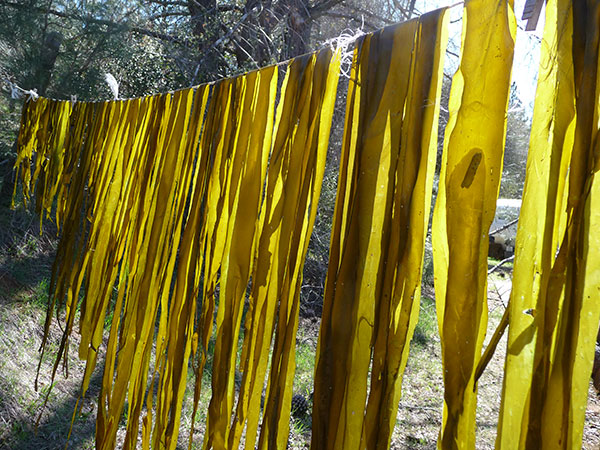
Harvesting Fresh Seaweed
Fresh kelp seaweed can be harvested from coastal regions conductive to their growth. They tend to grow more abundantly in the early summer season, but can be harvested to some degree all year long. If you have never harvested your own seaweed, it is a worthy adventure and a very fulfilling experience, connecting you with natural marine environments and the abundant food supply in which they can produce.
(Please visit our page on seaweed harvesting in the link below for tips and helpful information for gathering clean and vibrant sea vegetables.)
If you would like to harvest fresh seaweeds on the Northern Pacific
coastline and are concerned about radioactive contamination, you can
visit the non-profit organization Berkeley RadWatch
for more information on current findings. According to the Berkeley
RadWatch website as of 2014, "To date, no radioactive cesium that can be
attributed to Fukushima has been observed."
Purchasing High Quality Seaweeds
When it comes to purchasing seaweeds, quality is especially important.
While seawater contains a wealth of minerals and phytonutrients beneficial to health, it can also be contaminated from human created substances, like petroleum residues, radioactive isotopes, sewage waste, pesticides and herbicides as well as heavy metals.
It is therefore particularly important that the seaweeds we consume, not only come from pristine ocean waters that are less likely to be exposed to these toxic substances, but also seaweeds that undergo testing through independent lab inspection to monitor potential impurities. We also recommend suppliers who have taken additional measures to provide organic certification via controlled seawater environments.
It is best to therefore avoid most of the kombu and wakame seaweeds cultivated off the coast of Japan, due to the higher potential of radioactive contaminants from the 2011 Fukushima nuclear disaster.
Most higher quality seaweeds available today often come from the colder, more pristine, Northern Hemisphere zones.
Top Recommended Kelp Seaweed Brands
- Maine Coast Sea Vegetables - Offers the most thoroughly tested seaweeds available and are OCIA Certified Organic.
- Seaweed Iceland - Harvested from notoriously clean and pollution-free waters of the Reykjanes peninsula located at the southwestern end of Iceland.
- Mountain Rose Herbs - Offers cultivated organically grown kelp seaweed, sourced from controlled Icelandic seawater pools. Available as a powder or encapsulated product.
Types of Kelp
- Dried Whole Seaweed - These are larger raw dried pieces or long strips of kelp that vary widely in size, thickness and textural qualities.
- Powder - Comes granulated or as a fine powder.
- Tablets or Capsules - Sold as encapsulated kelp powders or compressed tablets. It is important to choose a reputable brand when purchasing supplements as they are not usually regulated for purity.
- Kelp Noodles - A fairly recent invention made from the sodium alginate or algin extracted from certain kelp species.
- Fresh Seaweed - Freshly harvested seaweeds that can be dried or used directly in recipes.


How to Use
Any raw dried kelp seaweed, in the form of granules, powder or whole pieces, can be directly added to foods and hot liquids. Traditionally, kombu is a very important ingredient used to flavor and thicken soups and stews in countries like Japan, China and Korea.
Thicker pieces of dried kelp, wakame or kombu, when simmered into soup stocks, are known to release many of their polysaccharides and other beneficial nutrients into the broth liquid. After the heating process the seaweed is much softer and can be eaten straight, Japanese-style or removed.
Dried long kelp pieces are often used when cooking grains and especially beans to help increase their digestibility and reduce flatulence.
These whole dried varieties can likewise be pickled into cultured vegetables such as kimchi or fermented into tempeh, but should be first soaked to remove excess mucilage.
Other softer kelp species can be sliced and used in seaweed salads along with other Laminariales like arame and sea palm. Most all types will expand to about 5 times their dried weight when soaked in liquid.
Kelp noodles are also now a common item found in many Western health food stores. They are a slightly processed, but raw, version of kelp made by extracting the sodium alginate, adding water and forming it into a clear noodle-like shape. They are best when softened slightly by heating or marinating.
Kelp granules or powder can be sprinkled on foods as a salt substitute or incorporated into marinades as the glutamate content enhances flavor and tenderizes other foods used with it. However, remember that kelp can sometimes have a strong fishy flavor that is often best when used in savory dishes or camouflaged into recipes as a thickening agent.
We add kelp to our raw soup recipes, miso soups, homemade black bean tempeh and use kelp noodles in our raw mac-n-cheese. (See links below)
Although kelp is also available as tablets or capsules, these supplements are often a lower quality. If you prefer to consume kelp in this form, we recommend making your own encapsulated powders from higher quality powders for greater nutritional value and purity.
Kelp Dosage
Because certain types of kelp are more concentrated in phytonutrients,
like iodine, it is good to regulate dose according to your personal
constitution and health goals. A very high quality kelp powder, like
Maine Coast Sea Vegetables Kelp Blend, contains between 9000-10500 mcg (9 mg) of iodine in a 3
gram serving (1 teaspoon), which is considerable high compared to other varieties.
This might work very well for some individuals but can cause health issues for those susceptible to excess iodine intake.
There are also other nourishing seaweed varieties available like nori, dulse or irish moss, with lower amounts of iodine, which may be more suitable for certain people.
Precautions:
Seek the advice of your medical physician if you have had a pre-existing thyroid disease or are currently diagnosed with a thyroid condition. Avoid iodine supplements and kelp seaweed products if you are sensitive to excessive intake or have severe allergies to fish or seafood.
Shop Related Products (About Affiliates & Amazon Associate Paid Links)
Affiliate Disclaimer: This section contains affiliate product links. If you make a purchase through our recommended links, we receive a small commission at no additional cost to you. Thanks for the support.
